Connect 3D and Sapphire Blizzard Radeon X1900 XTX
by Josh Venning on April 10, 2006 12:05 AM EST- Posted in
- GPUs
Test Setup/Performance
Now we're taking a look at the overall performance of these two cards at both factory clock speeds (out of the box) and overclocked speeds in a few standard games. This is our typical performance setup and should look pretty familiar. Our single-core FX-55 may be holding back performance in Quake 4 a bit with the latest SMP patch, but we're running at resolutions that should be GPU-limited anyway.

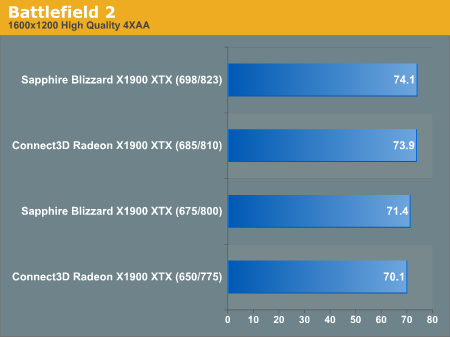
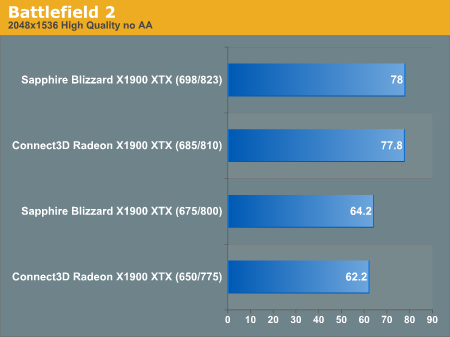
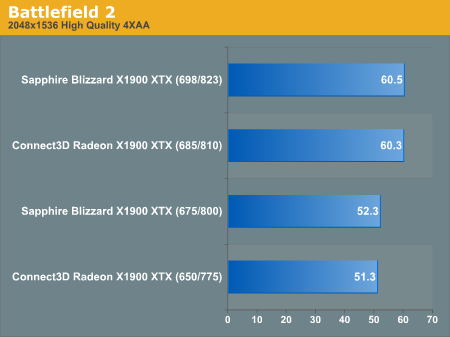
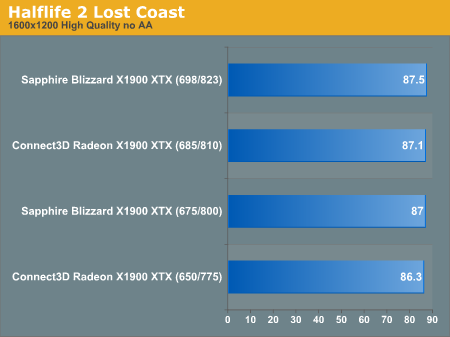
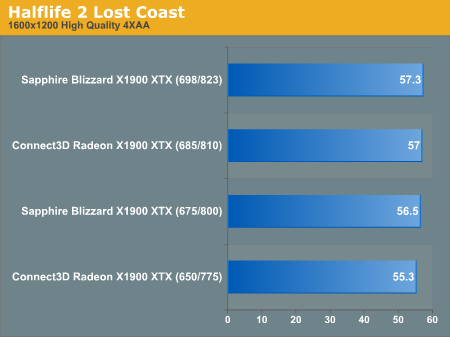
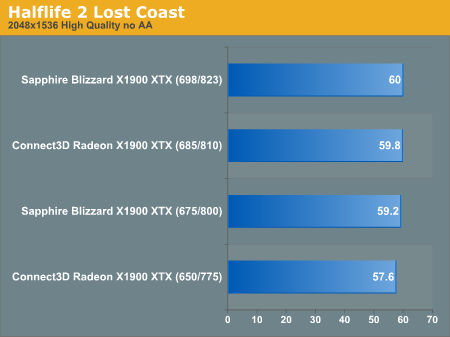
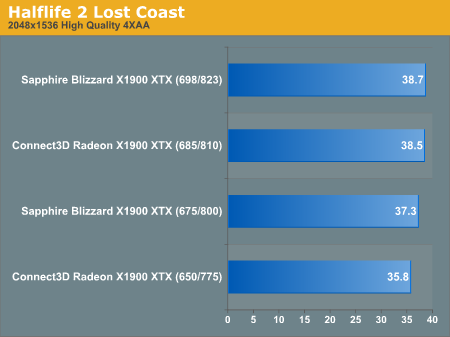
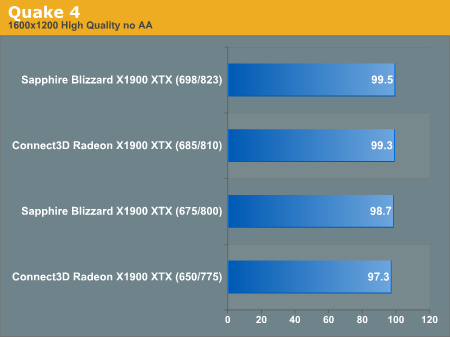
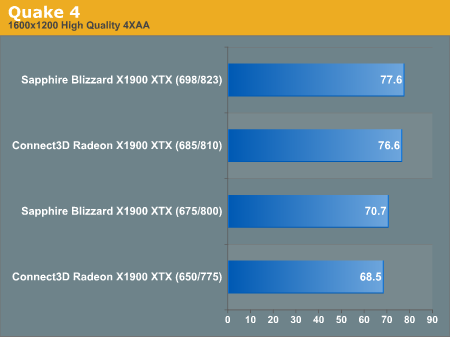
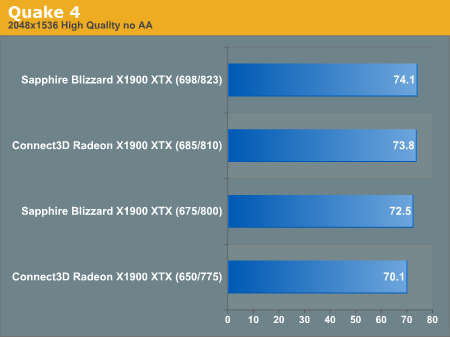
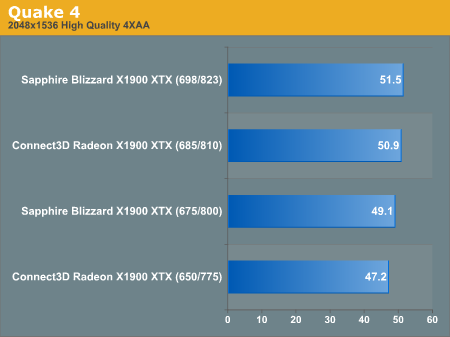
Of course we notice right away here that due to the higher factory overclock, the Blizzard X1900 XTX performs slightly better than the Connect3D. There isn't a huge difference though, and whether or not the performance increase is worth the higher price is debatable. Higher clock speeds aren't the Blizzard's only benefits, of course, as it provides better performance with lower noise levels.
Now we're taking a look at the overall performance of these two cards at both factory clock speeds (out of the box) and overclocked speeds in a few standard games. This is our typical performance setup and should look pretty familiar. Our single-core FX-55 may be holding back performance in Quake 4 a bit with the latest SMP patch, but we're running at resolutions that should be GPU-limited anyway.
| System Configuration | |
| Motherboard | NVIDIA nForce 4 motherboard |
| CPU | AMD Athlon 64 FX-55 2.6 GHz Processor |
| RAM | 1 GB OCZ 2:2:2:6 DDR400 RAM |
| HDD | Seagate 7200.7 120 GB Hard Drive |
| PSU | OCZ 600 W PowerStream Power Supply |












Of course we notice right away here that due to the higher factory overclock, the Blizzard X1900 XTX performs slightly better than the Connect3D. There isn't a huge difference though, and whether or not the performance increase is worth the higher price is debatable. Higher clock speeds aren't the Blizzard's only benefits, of course, as it provides better performance with lower noise levels.










24 Comments
View All Comments
Gioron - Thursday, April 13, 2006 - link
As soon as I saw the cooling system I had flashbacks to http://www.dansdata.com/aguatec.htm">this review and http://www.dansdata.com/thermagic.htm">this almost as bad review. There is almost no situation where the water cooling card is a good idea. There is no magic mystical power of water to cool things down, its just an easy way to transfer heat from one place to annother. In the case of most sane water cooling rigs, this means transfering the heat from the small CPU contact patch to the large efficient/quiet radiator elsewhere. You lose efficiency by adding water to the loop, but you more than make up for it with a huge unwieldy radiator that would never fit on the CPU under normal circumstances.However, in this situation (and in the first linked review) you're moving the heat from the processor contact to a radiator thats exactly the same size and efficiency as one you could attach directly to the processor, which means you lose efficiency moving the heat and then have no way to make up for it. As noted in the article, it does take a bit for the water to warm up which slows the temperature increase, but the final temperature MUST be higher than the temperature of the same heat sink just bolted directly onto the core. Anyone who even glanced at a thermodynamics textbook can tell you that. You may be able to get the water cooling system close to the efficiency of a normal heat sink, but you'll never exceed it and the marketing speel is complete and utter BS.
There is, however, one possible use for this card. Some shuttle boxes have the GPU slot right next to the side of the case, preventing the installation of cards with dual slot coolers. You can use this card to move the heatsink on the other side of the card and get cooling almost as good as a dual slot cooler, but the real solution to this problem is just for the case to be constructed such that dual card coolers will actually fit. (And since I haven't looked at shuttle cases much since I bought mine, they may actually have figured this out by now, leaving this card to be completely pointless.)
tekkstore - Monday, April 17, 2006 - link
https://www.tekkstore.com">tekkstore.comtekkstore - Monday, April 17, 2006 - link
https://www.tekkstore.com">tekkstore.comyacoub - Wednesday, April 12, 2006 - link
Fixed it for you. The numbers listed indicate they are both very loud and neither would be appropriate for a quiet system or HTPC.
jmke - Tuesday, April 11, 2006 - link
Hello, are these "A" weighed?jmke - Tuesday, April 11, 2006 - link
forgot to ask; at what distance? was the card inside a case?haelduksf - Monday, April 10, 2006 - link
"Bigger reservoir = more heat capacity" is a common myth, but a myth none the less. Adding more water to a loop doesn't result in any meaningful increase in heat capacity, and a larger res usually puts more strain on your pump to boot.NegativeEntropy - Monday, April 10, 2006 - link
I think what you menat was more water does not equal lower temps. By definition more coolant does indeed increase the total heat capacity of the system assuming the same fluid.JarredWalton - Monday, April 10, 2006 - link
Exactly, which is what was intended in this article.If you have a gallon of water vs. a quart of water, both at 25 C, the gallon can absorb 4X as much heat before turning to vapor (not that you'd ever get it that hot with a computer system....) Taken to the extreme, you could have a system sucking water from the ocean and spewing back slightly warmer water into the ocean, and it would never really change the ocean's temperature. The only extra strain on a pump would be if the pump has to pull/push water through more pipes.z3R0C00L - Monday, April 10, 2006 - link
Actually adding more water can make a difference provided you have a larger heat dissipator (radiator).But I do agree adding more water does not mean better temps.. you need a larger dissipator to remove the heat from that extra water. At least using the logic I have an x1900XT clocked at 750/1700 using water and no voltage tweaks or increases.